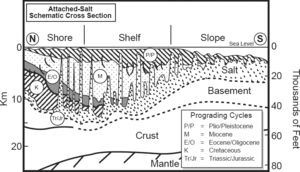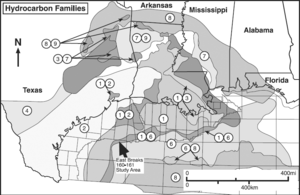East Breaks source rock
| Exploring for Oil and Gas Traps | |

| |
| Series | Treatise in Petroleum Geology |
|---|---|
| Part | Critical elements of the petroleum system |
| Chapter | Sedimentary basin analysis |
| Author | John M. Armentrout |
| Link | Web page |
| Store | AAPG Store |
Identification problem
Geochemical typing of an oil in a reservoir rock and its correlation to a probable source rock are used to determine the level of certainty or the confidence that an oil originated from a specific source. Oils from the East Breaks 160-161 field have been analyzed by Dow et al.[1] Those oils, one each from the Glob alt GA-3 reservoir and the Hyal B HB-2 reservoir, are very similar geochemically and closely resemble continental shelf oils of Louisiana and Texas. The East Breaks 160-161 Glob alt and Hyal B oils do not correlate with the Type 1-B oils[2] of shelf-edge and continental slope reservoirs[1]
Miocene source?

Dow et al.[1] present a case for a Miocene source rock for the East Breaks 160-161 field, based primarily on the interpretation that the East Breaks 160-161 minibasin is a self-contained petroleum system enclosed by a salt floor and walls, and thus the hydrocarbons must have been generated from within (see Figure 1). Those workers present analyses of kerogens from late Miocene gravity-flow-deposited mudstones, suggesting some potential for oil generation, and speculate that more deeply buried, more organic-rich middle Miocene mudstones may be the source of the hydrocarbons. Taylor and Armentrout[4] analyzed oils and kerogens in turbidite facies at the High Island A-537 field. They speculate that kerogens in Neogene turbidite facies are unlikely to be the source of oils in the A-537 field and further speculate that deeper source rocks with a strong marine algal fingerprint were more likely sources for the oils.
Early Tertiary source?

Gross et al.[5] suggest that the oil of the East Breaks–High Island area originated from either lower Tertiary mudstones or uppermost Jurassic mudstones (Figure 2). Philippi[7] and Sassen et al.[8] present evidence for source potential for crude oil in the upper Paleocene to lower Eocene Wilcox Formation. If lower Tertiary Wilcox equivalent or uppermost Jurassic mudstones are the source for hydrocarbons in the East Breaks 160-161 field, then a migration avenue must exist through the salt that underlies the minibasin and generation-migration-accumulation must have been delayed until the trap formed approximately 1.2 Ma. In fact, alternative interpretations of salt distribution at the East Breaks 160-161 field suggest a salt weld with sediment-on-sediment below the minibasin rather than a salt floor (compare Figures 1 and 3). This suggests migration could have occurred from even older, more deeply buried source rocks.
Migration pathways
Data currently available preclude a precise correlation of the East Breaks 160-161 field oils with a specific source rock. Therefore, the petroleum system(s) charging the Glob alt reservoirs is speculative. However, the data do suggest that the hydrocarbons originate from more deeply buried thermally mature rocks than those encasing the reservoir and therefore vertical migration has occurred.
Future work
Detailed biomarker analysis of the East Breaks oils and comparison to detailed analyses of potential source rocks are necessary for a precise correlation and resolution of relatively shallow middle Miocene vs. much deeper lower Tertiary source rocks for the East Breaks 160-161 field hydrocarbons. If this exercise is successful, then the level of certainty for these petroleum systems could be raised to known.
See also
- East Breaks petroleum system
- East Breaks reservoir rock
- East Breaks seal rock
- East Breaks overburden rock
References
- ↑ 1.0 1.1 1.2 Dow, W. G., M. A. Yukler, J. T. Senftle, M. C. Kennicutt II, and J. M. Armentrout, 1990, Miocene oil source beds in the East Breaks basin, Flex-Trend, offshore Texas: Proceedings, Gulf Coast Section SEPM 9th Annual Research conference, p. 139–150.
- ↑ Thompson, K. F. M., M. C. Kennicutt II, and J. M. Brooks, 1990, Classification of offshore Gulf of Mexico oils and gas condensates: AAPG Bulletin, vol. 74, p. 187–198.
- ↑ Antoine, J. W., R. G. Ray, Jr., T. G. Pyle, and W. R. Bryant, 1974, Continental margins of the Gulf of Mexico, in C. A. Burk and C. L. Drake, eds., The Geology of Continental Margins: New York, Springer-Verlag, p. 683–693.
- ↑ Taylor, G. S., and J. M. Armentrout, 1990, Rock geochemistry and relationships to produced oils from upper Pliocene turbidites, High Island area, Gulf of Mexico: Proceedings, Gulf Coast Section SEPM 9th Annual Research conference, p. 151–161.
- ↑ 5.0 5.1 Gross, O. P., K. C. Hood, L. M. Wenger, and S. C. Harrison, 1995, Seismic imaging and analysis of source and migration within an integrated hydrocarbon system study, northern Gulf of Mexico basin: Abstracts, 1st Latin American Geophysical conference, p. 1–4.
- ↑ Hall, D. J., B. E. Bowen, R. N. Rosen, S. Wu, and A. W. Bally, 1993, Mesozoic and early Cenozoic development of the Texas margin: a new integrated cross-section from the Cretaceous shelf edge to the Perdido fold belt: Selected Papers, Gulf Coast Section SEPM 13th Annual Research Conference, p. 21–31.
- ↑ Philippi, G. T., 1974, The influence of marine and terrestrial source material on the composition of petroleum: Geochim. Cosmochim. Acta, vol. 38., p. 947–966., 10., 1016/0016-7037(74)90067-2
- ↑ Sassen, R., R. S. Tye, E. W. Chinn, and R. C. Lemoine, 1988, Origin of crude oil in the Wilcox Trend of Louisiana and Mississippi: evidence of long range migration: Gulf Coast Assoc. Geological Societies Transactions, vol. 38, p. 27–34.
